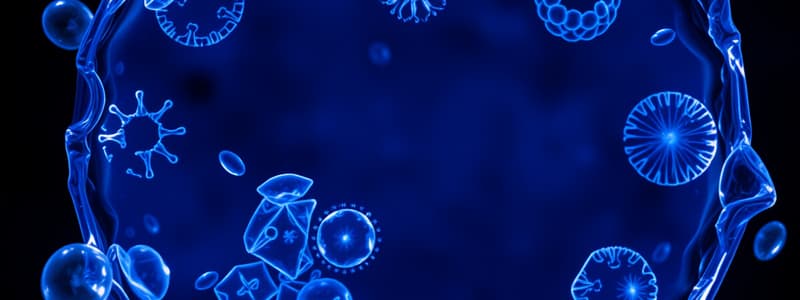Podcast
Questions and Answers
What is the cell cycle?
What is the cell cycle?
- The separation of sister chromatids during mitosis
- The duplication of chromosomes
- The ordered sequence of events that a cell passes through between one cell division and the next (correct)
- A process of DNA replication
What is a centromere?
What is a centromere?
Region at which sister chromatids are bound together
Define chromatid.
Define chromatid.
Single DNA molecule of two strands of duplicated DNA held together at the centromere
What does diploid mean?
What does diploid mean?
What is a gamete?
What is a gamete?
Define a gene.
Define a gene.
What is a genome?
What is a genome?
What does haploid mean?
What does haploid mean?
Define histone.
Define histone.
What are homologous chromosomes?
What are homologous chromosomes?
What is the locus?
What is the locus?
What is a nucleosome?
What is a nucleosome?
A diploid cell has _______ the number of chromosomes as a haploid cell.
A diploid cell has _______ the number of chromosomes as a haploid cell.
An organism's traits are determined by the specific combination of inherited _____.
An organism's traits are determined by the specific combination of inherited _____.
The first level of DNA organization in a eukaryotic cell is maintained by which molecule?
The first level of DNA organization in a eukaryotic cell is maintained by which molecule?
Identical copies of chromatin held together by cohesin at the centromere are called _____.
Identical copies of chromatin held together by cohesin at the centromere are called _____.
Compare and contrast a human somatic cell to a human gamete.
Compare and contrast a human somatic cell to a human gamete.
What is the relationship between a genome, chromosomes, and genes?
What is the relationship between a genome, chromosomes, and genes?
Explain how eukaryotic chromosomes can fit inside a nucleus.
Explain how eukaryotic chromosomes can fit inside a nucleus.
What stage of mitosis involves sister chromatids being separated?
What stage of mitosis involves sister chromatids being separated?
What does a cell plate indicate?
What does a cell plate indicate?
Flashcards are hidden until you start studying
Study Notes
Cell Cycle Overview
- The cell cycle consists of an ordered sequence of events between cell divisions, necessary for growth and reproduction.
Key Terms and Definitions
- Centromere: A constricted region where sister chromatids are joined, pivotal in chromosome alignment during cell division.
- Chromatid: Each of the two duplicated strands of DNA held together at the centromere; essential for proper chromosome segregation.
- Diploid (2n): Cells or organisms that carry two sets of chromosomes, typical in somatic cells.
- Gamete: A haploid reproductive cell (sperm or egg), containing one set of chromosomes.
- Gene: The basic unit of heredity, consisting of DNA sequences that encode proteins, influencing traits.
- Genome: The complete set of genetic material present in a cell or organism, encapsulating all chromosomes.
- Haploid (n): Refers to cells with a single set of chromosomes, characteristic of gametes.
- Histone: Basic proteins that play a critical role in the packaging of DNA into nucleosomes, aiding in DNA organization.
- Homologous Chromosomes: Chromosome pairs of the same morphology, each inherited from a different parent, holding similar genes.
- Locus: The specific physical location of a gene on a chromosome.
- Nucleosome: The fundamental unit of chromatin, formed by DNA wrapped around histones, facilitating compaction of genetic material.
Chromosome Characteristics
- A diploid cell carries twice the number of chromosomes compared to a haploid cell, emphasizing genetic diversity through sexual reproduction.
- Traits in an organism are influenced by the inherited genes from both parents, as part of their DNA.
- Histones are crucial for the initial stage of DNA configuration in eukaryotic cells.
Cellular Division Phases
- Sister chromatids refer to identical copies of chromatin linked at the centromere and separated during mitosis.
- Human somatic cells harbor 46 chromosomes (22 pairs of autosomes and 2 sex chromosomes), while human gametes contain 23 chromosomes, reflecting their diploid and haploid states, respectively.
Genetic Structure Relationships
- The genome is the collective total of an organism’s chromosomes; each chromosome comprises numerous genes with coding and non-coding DNA.
Chromatin Structure and Function
- Eukaryotic chromosomes exceed typical cell length and are compacted through wrapping around histones to form nucleosomes, further organized into fibers.
- The mechanism of chromatin condensation is essential for effective chromosome segregation during division.
Summary of Genetic Concepts
- Prokaryotes possess a singular circular chromosome, while eukaryotes have multiple linear chromosomes encased within a nucleus.
- In human somatic cells, chromosomes are categorized as 22 pairs of autosomes plus 2 sex chromosomes, indicating diploid nature.
- Mitosis requires chromosomes to be highly condensed for accurate segregation, achieved through various proteins aiding in DNA organization.
Mitosis Stage
- Anaphase: A critical phase in mitosis where sister chromatids are pulled apart, ensuring each new daughter cell receives an identical set of chromosomes.
Additional Cell Cycle Concept
- Cell Plate: A structure involved in plant cell division, forming during cytokinesis, aiding in the separation of daughter cells.
Studying That Suits You
Use AI to generate personalized quizzes and flashcards to suit your learning preferences.




